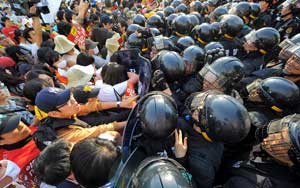
Follow workers.org on



RED HOT: TRAYVON MARTIN
CHINA,
AFGHANISTAN, FIGHTING RACISM, OCCUPY WALL STREET,
PEOPLE'S POWER, SAVE OUR POST OFFICES, WOMEN, AFRICA,
LIBYA, WISCONSIN WORKERS FIGHT BACK, SUPPORT STATE & LOCAL WORKERS,
EGYPT, NORTH AFRICA & MIDDLE EAST,
STOP FBI REPRESSION, RESIST ARIZONA RACISM, NO TO FRACKING, DEFEND PUBLIC EDUCATION, ANTI-WAR,
HEALTH CARE,
CUBA, CLIMATE CHANGE,
JOBS JOBS JOBS,
STOP FORECLOSURES, IRAN,
IRAQ, CAPITALIST CRISIS,
IMMIGRANTS, LGBT, POLITICAL PRISONERS,
KOREA,
HONDURAS, HAITI,
SOCIALISM,
GAZA



|
|
Strikes, protests besiege South Korean regime
By
Sara Flounders
Published Jun 19, 2008 1:22 AM
South Korea has been seeing nightly mass demonstrations for over a month, a
candlelight march of 1 million people on June 10 and a strike wave of key
industrial unions. All are connected to a trade agreement between Washington
and the current government of President Lee Myung-bak that would allow U.S.
beef into the country.
|
South Koreans protesting U.S. beef imports
try to march to president’s home.
|
This huge movement is the biggest challenge to date to U.S.-imposed trade
agreements around the world. The escalating mass actions deserve to be watched
closely and supported fully.
So far no government in Washington’s orbit has been able to resist the
trade conditions imposed on them by the combined pressure of U.S. corporations,
government negotiators, and the military reinforced by international banking
institutions such as the IMF, World Bank and World Trade Organization.
In many countries of the developing world U.S.-imposed trade agreements have
undermined and all but destroyed locally grown food production. They have
driven tens of millions of small farmers off the land and created famines in
the midst of surplus. They have also spread genetically modified, uninspected
and tainted food into global food distribution networks.
The huge demonstrations and strikes in South Korea show that such agreements,
imposed through complicit governments, can be challenged by a mass grassroots
movement.
March of a million
Over 1 million people in the capital, Seoul, flooded the streets in candle-lit
demonstrations on June 10. It was the largest demonstration in South
Korea’s history. Eighty other cities also held protests that
day—the anniversary of the 1987 June Popular Resistance movement that had
overturned the U.S.-backed military dictatorship in South Korea.
A coalition of 1,500 civic, union and student groups known as the
People’s Council for Countermeasures Against Mad Cow Disease had begun
nightly vigils on April 27 that drew many thousands.
In face of the rising mass anger, President Lee offered to have his entire
cabinet resign. With his popularity ratings sinking below 17 percent, Lee has
repudiated many of his own right-wing market plans and has promised
concessions, loans and subsidies. But the demonstrations have emboldened the
opposition. Now the calls “Out with President Lee” are
everywhere.
Lee has been in office just over three months. His Grand National Party is
associated with the years of military dictatorship. He came into the presidency
promising rapid growth, sweeping market reforms, privatization of nationally
owned firms and banks, painful revisions in pensions and social programs, and
tax cuts for the rich along with greater openness to foreign investments and
friendlier relations with the U.S. A new hostility in relations with the
Democratic People’s Republic of Korea in the north reflects Lee’s
whole orientation and U.S. pressure.
But Lee’s business-friendly policies ran into globally rising food and
fuel prices and an economic downturn with rising unemployment.
The beef with ‘free trade’
The immediate focus of mass anger in South Korea is a trade concession allowing
U.S. beef imports. President Lee was required to lift a ban on U.S. beef that
had been in place in order to secure the U.S.-Korea Free Trade Agreement. This
was seen as an attack on the sovereignty of South Korea.
Before 2003 the country was the third-largest importer of U.S. beef. Then the
discovery of an imported cow infected with mad cow disease led to the ban.
South Korea is hardly alone in banning U.S. beef. Sixty-five countries,
including every one in the European Union, ban U.S. beef.
According to Christian Ahn, “USDA tests only one out of 1,000 cows....
Japan surveys every cow, Europe one in four, and Canada one out of 250.”
(Foreign Policy in Focus, June 13) The U.S. Congress has not even passed a ban
on eating “downed animals”–animals too sick or injured to
walk that are dragged to the slaughterhouse.
“Last year, some 200 million pounds of beef were recalled from the U.S.
food supply,” says Dr. Michael Gregor of the Humane Society of the U.S.
“This is a staggering amount.”
U.S. capitalist economists see the tens of thousands of demonstrators in South
Korea as a sign that “After six decades of ever-expanding international
commerce, the high tide of free trade is ebbing.” (Bloomberg News, June
13)
Festival of resistance
The nights of demonstrations have especially aroused the creative energy of the
youth, who use their skills to create their own media and to organize
spontaneous actions and confrontations. Laser projectors write slogans in the
night sky, there are impromptu concerts, and encampments, with tents and gear
spread out, block traffic at major intersections.
Some 37,000 riot police have been mobilized, 20,000 of them in Seoul against
the demonstrations. The government has ordered huge metal shipping containers
to be stacked in solid walls of barricades to prevent demonstrators from
reaching the presidential “Blue House” or other government
ministries.
Thousands of police have arrested, beaten and used high-pressure water hoses on
the demonstrators. Youth with video cameras have recorded the attacks and
posted them nightly on youtube and other sites.
Workers’ movement comes forward
With hundreds of thousands of people taking to the streets night after night
and the government clearly on the defensive, the political climate has been
transformed. The workers’ movement has come forward with its own
demands.
Faced with rising fuel prices, 13,000 truck drivers were the first to go on a
three-day strike demanding a fuel subsidy and a guaranteed minimum wage. Only a
fraction of South Korea’s truck drivers are unionized. They were joined
by thousands of non-union contract truckers facing even more difficult
conditions. Their actions impacted immediately on production at big electronics
factories, auto and steel works.
South Korea has an export-driven economy. The vast commercial port of Busan
ground almost to a halt. At the port of Incheon only 157 drivers are unionized,
but 2,000 non-union drivers also refused to deliver cargo.
The Federation of Peasants Associations has raised its own demands, along with
the Teachers union, the Federation of Government Employees, and the Court
Employees union. The Korean Federation of Public Services is planning future
walkouts.
Businesses owners fear the worst. “Rising calls for a general strike were
significantly strengthened on Monday as thousands of building sites across
South Korea were silenced by striking cement mixer drivers.” (Asia
Business, June 16)
Workers in Seoul are pushing for mass walkouts across the economy. Asia
Business quoted Korean Confederation of Trade Unions President Lee Seok-haeng
explaining the union strategy: “We will walk out like the baseball
batting order goes; the first batter is the Korea Cargo Transport
Workers’ Union, the second batter is the construction and machinery
workers, followed by the metal workers and the railway workers.”
Then on June 17 the KCTU announced that a majority of its members had voted for
a nationwide general strike on July 2 to demand that the government cancel its
plans to privatize public corporations and renegotiate the beef import deal
with the U.S.
The Labor Ministry called the strike voted on by the 630,000-member
confederation an “illegal and political strike.” South Korea
“Justice” Minister Kim Kyung-han said the strikes by truckers and
the union federation were illegal and vowed to crack down on them.
The KCTU rejected the warning, saying the government had no legal basis to
brand the strike illegal and its threat would only deepen South Korean
President Lee’s political isolation.
The government attempted to clamp down on all coverage of the demonstrations
and the growing strike wave. The Federation of Press Trade Unions responded by
issuing a call for the resignation of both Lee’s cabinet and the chair of
the Broadcasting Organization.
The issue of U.S. beef imports has the potential to merge with a whole series
of other deeply felt grievances, including the ever-present resentment over
more than 50 years of U.S. occupation and the stationing of approximately
40,000 U.S. troops in South Korea.
Clearly a new stage of the struggle in South Korea is opening up. It will be
rich in experience for Korean youth and in lessons for a global movement
confronting U.S. trade demands.
Articles copyright 1995-2012 Workers World.
Verbatim copying and distribution of this entire article is permitted in any medium without royalty provided this notice is preserved.
Workers World, 55 W. 17 St., NY, NY 10011
Email: [email protected]
Subscribe [email protected]
Support independent news DONATE
|
|


